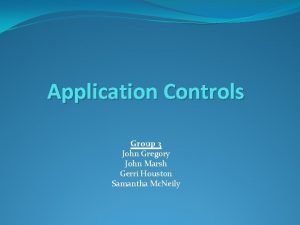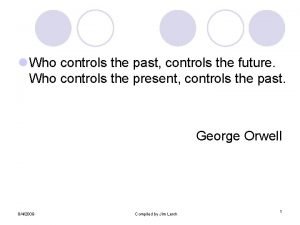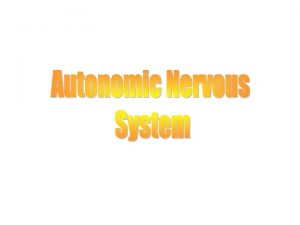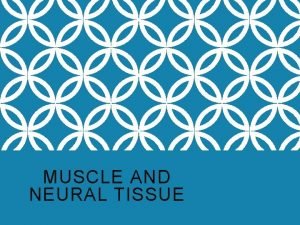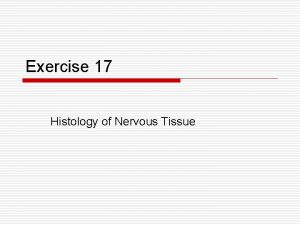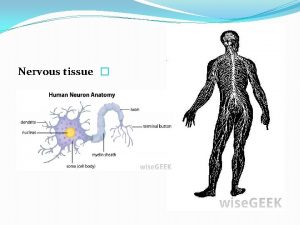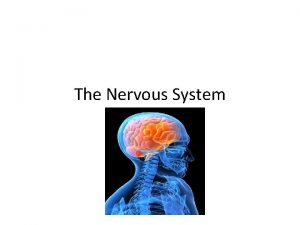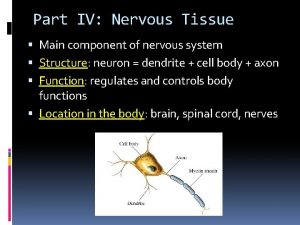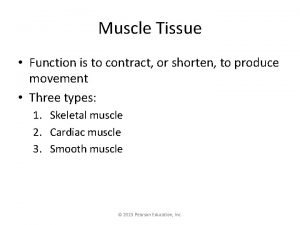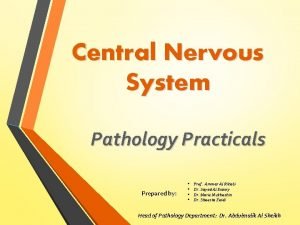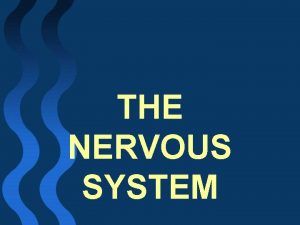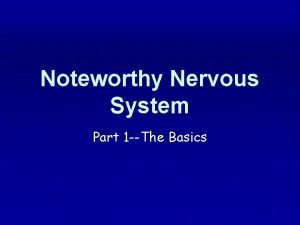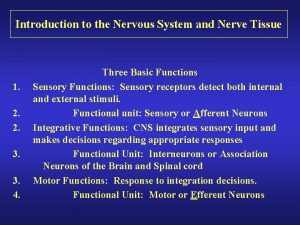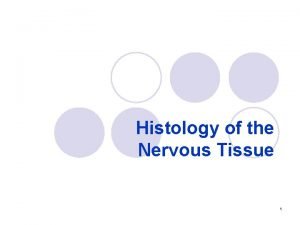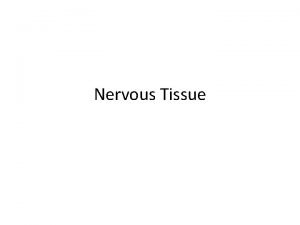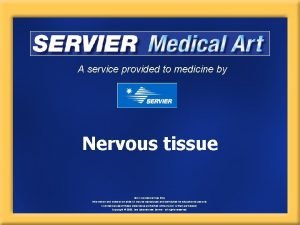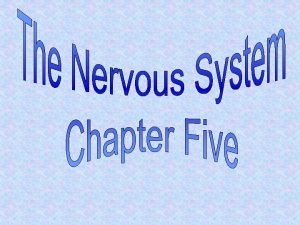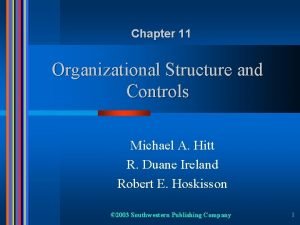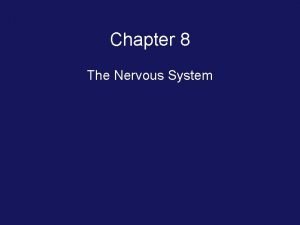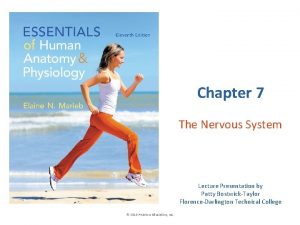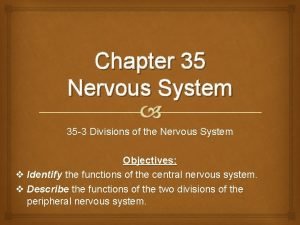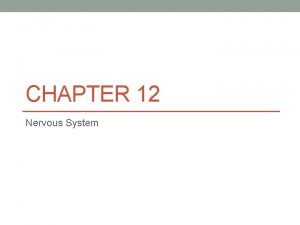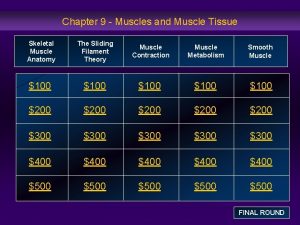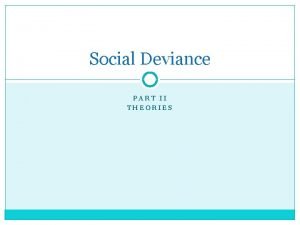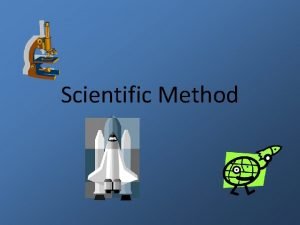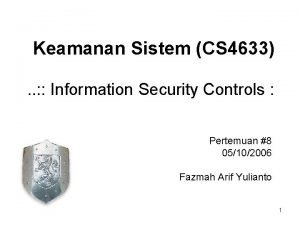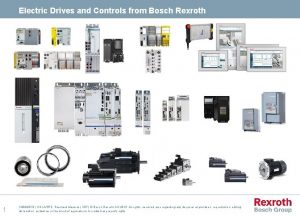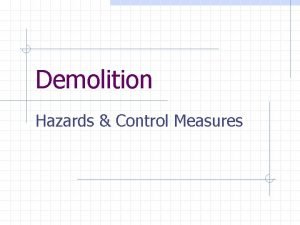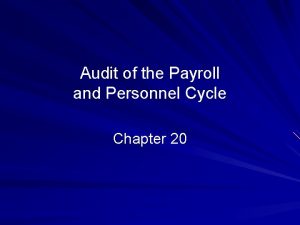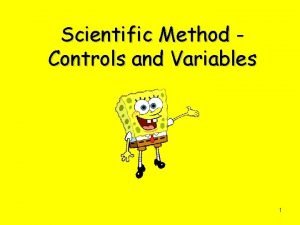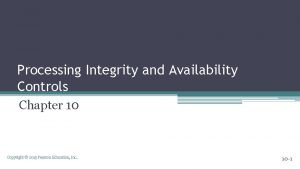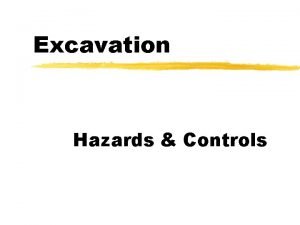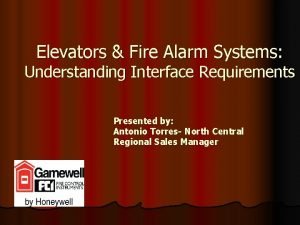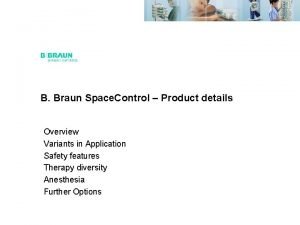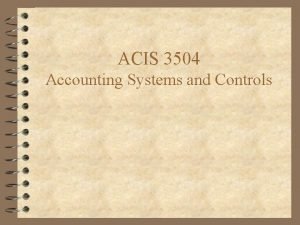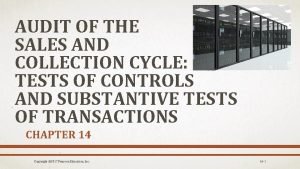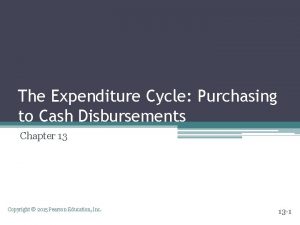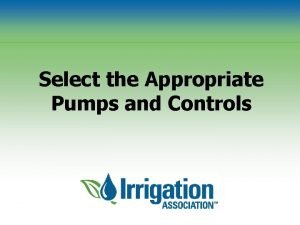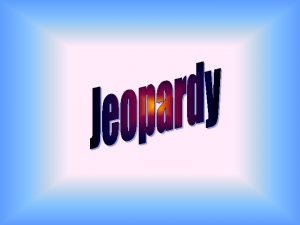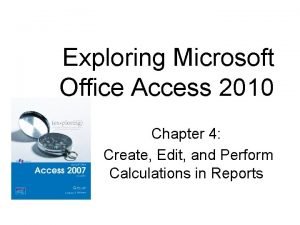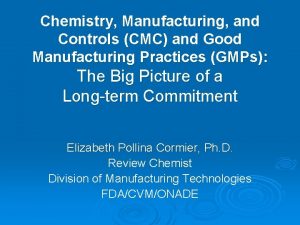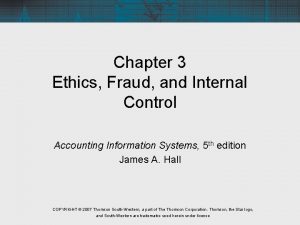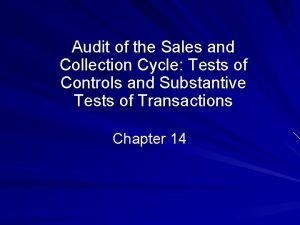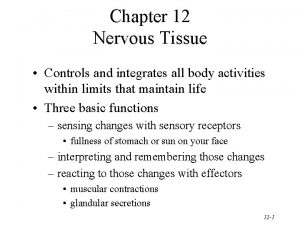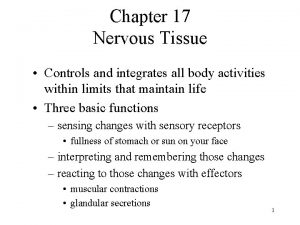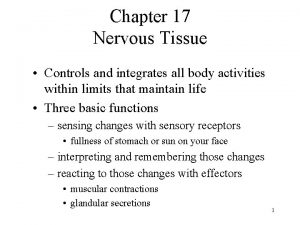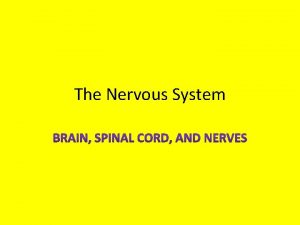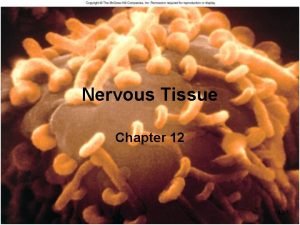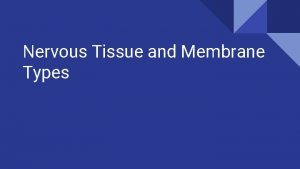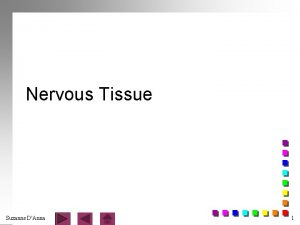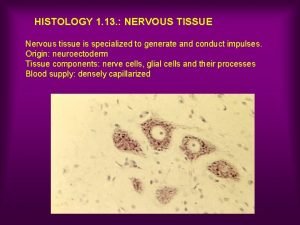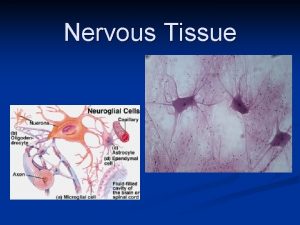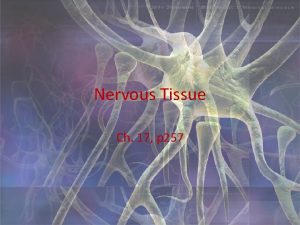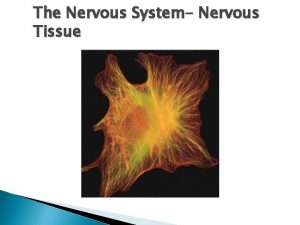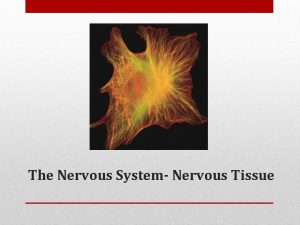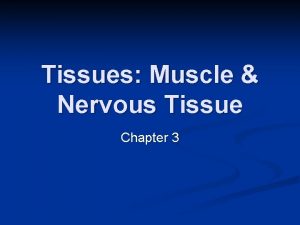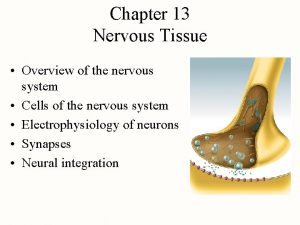Chapter 12 Nervous Tissue Controls and integrates all



































































- Slides: 67

Chapter 12 Nervous Tissue • Controls and integrates all body activities within limits that maintain life • Three basic functions – sensing changes with sensory receptors • fullness of stomach or sun on your face – interpreting and remembering those changes – reacting to those changes with effectors • muscular contractions • glandular secretions 1

Major Structures of the Nervous System • Brain, cranial nerves, spinal cord, spinal nerves, ganglia, enteric plexuses and sensory receptors 2

Organization of the Nervous System • CNS is brain and spinal cord • PNS is everything else 3

Nervous System Divisions • Central nervous system (CNS) – consists of the brain and spinal cord • Peripheral nervous system (PNS) – consists of cranial and spinal nerves that contain both sensory and motor fibers – connects CNS to muscles, glands & all sensory receptors 4

Subdivisions of the PNS • Somatic (voluntary) nervous system (SNS) – neurons from cutaneous and special sensory receptors to the CNS – motor neurons to skeletal muscle tissue • Autonomic (involuntary) nervous systems – sensory neurons from visceral organs to CNS – motor neurons to smooth & cardiac muscle and glands • sympathetic division (speeds up heart rate) • parasympathetic division (slow down heart rate) • Enteric nervous system (ENS) – involuntary sensory & motor neurons control GI tract – neurons function independently of ANS & CNS 5

Neurons • Functional unit of nervous system • Have capacity to produce action potentials – electrical excitability • Cell body – single nucleus with prominent nucleolus – Nissl bodies (chromatophilic substance) • rough ER & free ribosomes for protein synthesis – neurofilaments give cell shape and support – microtubules move material inside cell – lipofuscin pigment clumps (harmless aging) • Cell processes = dendrites & axons 6

Parts of a Neuron Neuroglial cells Nucleus with Nucleolus Axons or Dendrites Cell body 7

Dendrites • Conducts impulses towards the cell body • Typically short, highly branched & unmyelinated • Surfaces specialized for contact with other neurons • Contains neurofibrils & Nissl bodies 8

Axons • Conduct impulses away from cell body • Long, thin cylindrical process of cell • Arises at axon hillock • Impulses arise from initial segment (trigger zone) • Side branches (collaterals) end in fine processes called axon terminals • Swollen tips called synaptic end bulbs contain vesicles filled with neurotransmitters Synaptic boutons 9

Axonal Transport • Cell body is location for most protein synthesis – neurotransmitters & repair proteins • Axonal transport system moves substances – slow axonal flow • movement in one direction only -- away from cell body • movement at 1 -5 mm per day – fast axonal flow • • moves organelles & materials along surface of microtubules at 200 -400 mm per day transports in either direction for use or for recycling in cell body 10

Axonal Transport & Disease • Fast axonal transport route by which toxins or pathogens reach neuron cell bodies – tetanus (Clostridium tetani bacteria) – disrupts motor neurons causing painful muscle spasms • Bacteria enter the body through a laceration or puncture injury – more serious if wound is in head or neck because of shorter transit time 11

Functional Classification of Neurons • Sensory (afferent) neurons – transport sensory information from skin, muscles, joints, sense organs & viscera to CNS • Motor (efferent) neurons – send motor nerve impulses to muscles & glands • Interneurons (association) neurons – connect sensory to motor neurons – 90% of neurons in the body 12

Structural Classification of Neurons • Based on number of processes found on cell body – multipolar = several dendrites & one axon • most common cell type – bipolar neurons = one main dendrite & one axon • found in retina, inner ear & olfactory – unipolar neurons = one process only(develops from a bipolar) • are always sensory neurons 13

Association or Interneurons • Named for histologist that first described them or their appearance 14

Neuroglial Cells • • Half of the volume of the CNS Smaller cells than neurons 50 X more numerous Cells can divide – rapid mitosis in tumor formation (gliomas) • 4 cell types in CNS – astrocytes, oligodendrocytes, microglia & ependymal • 2 cell types in PNS – schwann and satellite cells 15

Astrocytes • Star-shaped cells • Form blood-brain barrier by covering blood capillaries • Metabolize neurotransmitters • Regulate K+ balance • Provide structural support 16

Oligodendrocytes • Most common glial cell type • Each forms myelin sheath around more than one axons in CNS • Analogous to Schwann cells of PNS 17

Microglia • Small cells found near blood vessels • Phagocytic role -- clear away dead cells • Derived from cells that also gave rise to macrophages & monocytes 18

Ependymal cells • Form epithelial membrane lining cerebral cavities & central canal • Produce cerebrospinal fluid (CSF) 19

Satellite Cells • Flat cells surrounding neuronal cell bodies in peripheral ganglia • Support neurons in the PNS ganglia 20

Schwann Cell • Cells encircling PNS axons • Each cell produces part of the myelin sheath surrounding an axon in the PNS 21

Axon Coverings in PNS • All axons surrounded by a lipid & protein covering (myelin sheath) produced by Schwann cells • Neurilemma is cytoplasm & nucleus of Schwann cell – gaps called nodes of Ranvier • Myelinated fibers appear white – jelly-roll like wrappings made of = myelin – acts as electrical insulator – speeds conduction of nerve impulses lipoprotein • Unmyelinated fibers – slow, small diameter fibers 22 – only surrounded by neurilemma but no myelin sheath wrapping

Myelination in PNS • Schwann cells myelinate (wrap around) axons in the PNS during fetal development • Schwann cell cytoplasm & nucleus forms outermost layer of neurolemma with inner portion being the myelin sheath • Tube guides growing axons that are repairing themselves 23

Myelination in the CNS • Oligodendrocytes myelinate axons in the CNS • Broad, flat cell processes wrap about CNS axons, but the cell bodies do not surround the axons • No neurilemma is formed • Little regrowth after injury is possible due to the lack of a distinct tube or neurilemma 24

Gray and White Matter • White matter = myelinated processes (white in color) • Gray matter = nerve cell bodies, dendrites, axon terminals, bundles of unmyelinated axons and neuroglia (gray color) – In the spinal cord = gray matter forms an H-shaped inner core surrounded by white matter – In the brain = a thin outer shell of gray matter covers the surface & is found in clusters called nuclei inside the CNS 25

Electrical Signals in Neurons • Neurons are electrically excitable due to the voltage difference across their membrane • Communicate with 2 types of electric signals – action potentials that can travel long distances – graded potentials that are local membrane changes only • In living cells, a flow of ions occurs through ion channels in the cell membrane 26

Two Types of Ion Channels • Leakage (nongated) channels are always open – nerve cells have more K+ than Na+ leakage channels – as a result, membrane permeability to K+ is higher – explains resting membrane potential of -70 m. V in nerve tissue • Gated channels open and close in response to a stimulus results in neuron excitability – voltage-gated open in response to change in voltage – ligand-gated open & close in response to particular chemical stimuli (hormone, neurotransmitter, ion) 27 – mechanically-gated open with mechanical stimulation

Gated Ion Channels 28

Resting Membrane Potential • Negative ions along inside of cell membrane & positive ions along outside – potential energy difference at rest is -70 m. V – cell is “polarized” • Resting potential exists because – concentration of ions different inside & outside • extracellular fluid rich in Na+ and Cl • cytosol full of K+, organic phosphate & amino acids – membrane permeability differs for Na+ and K+ • 50 -100 greater permeability for K+ • inward flow of Na+ can’t keep up with outward flow of K+ • Na+/K+ pump removes Na+ as fast as it leaks in 29

Graded Potentials • Small deviations from resting potential of -70 m. V – hyperpolarization = membrane has become more negative – depolarization = membrane has become more positive 30

How do Graded Potentials Arise? • Source of stimuli – mechanical stimulation of membranes with mechanical gated ion channels (pressure) – chemical stimulation of membranes with ligand gated ion channels (neurotransmitter) • Graded/postsynaptic/receptor or generator potential – ions flow through ion channels and change membrane potential locally – amount of change varies with strength of stimuli • Flow of current (ions) is local change only 31

Action Potential • Series of rapidly occurring events that change and then restore the membrane potential of a cell to its resting state • Ion channels open, Na+ rushes in (depolarization), K+ rushes out (repolarization) • All-or-none principal = with stimulation, either happens one specific way or not at all (lasts 1/1000 of a second) • Travels (spreads) over surface of cell without dying out 32

Depolarizing Phase of Action Potential • Chemical or mechanical stimulus caused a graded potential to reach at least (-55 m. V or threshold) • Voltage-gated Na+ channels open & Na+ rushes into cell – in resting membrane, inactivation gate of sodium channel is open & activation gate is closed (Na+ can not get in) – when threshold (-55 m. V) is reached, both open & Na+ enters – inactivation gate closes again in few ten-thousandths of second – only a total of 20, 000 Na+ actually enter the cell, but they change the membrane potential considerably(up to +30 m. V) • Positive feedback process 33

Repolarizing Phase of Action Potential • When threshold potential of -55 m. V is reached, voltage-gated K+ channels open • K+ channel opening is much slower than Na+ channel opening which caused depolarization • When K+ channels finally do open, the Na+ channels have already closed (Na+ inflow stops) • K+ outflow returns membrane potential to -70 m. V • If enough K+ leaves the cell, it will reach a -90 m. V membrane potential and enter the after-hyperpolarizing phase • K+ channels close and the membrane potential returns to the resting potential of -70 m. V 34

Refractory Period of Action Potential • Period of time during which neuron can not generate another action potential • Absolute refractory period – even very strong stimulus will not begin another AP – inactivated Na+ channels must return to the resting state before they can be reopened – large fibers have absolute refractory period of 0. 4 msec and up to 1000 impulses per second are possible • Relative refractory period – a suprathreshold stimulus will be able to start an AP – K+ channels are still open, but Na+ channels have closed 35

The Action Potential: Summarized • Resting membrane potential is -70 m. V • Depolarization is the change from -70 m. V to +30 m. V • Repolarization is the reversal from +30 m. V back to -70 m. V) 36

Propagation of Action Potential • An action potential spreads (propagates) over the surface of the axon membrane – as Na+ flows into the cell during depolarization, the voltage of adjacent areas is effected and their voltage-gated Na+ channels open – self-propagating along the membrane • The traveling action potential is called a nerve impulse 37

Local Anesthetics • Prevent opening of voltage-gated Na+ channels • Nerve impulses cannot pass the anesthetized region • Novocaine and lidocaine 38

Continuous versus Saltatory Conduction • Continuous conduction (unmyelinated fibers) – step-by-step depolarization of each portion of the length of the axolemma • Saltatory conduction – depolarization only at nodes of Ranvier where there is a high density of voltage-gated ion channels – current carried by ions flows through extracellular fluid from node to node 39

Saltatory Conduction • Nerve impulse conduction in which the impulse jumps from node to node 40

Speed of Impulse Propagation • The propagation speed of a nerve impulse is not related to stimulus strength. – larger, myelinated fibers conduct impulses faster due to size & saltatory conduction • Fiber types – A fibers largest (5 -20 microns & 130 m/sec) • myelinated somatic sensory & motor to skeletal muscle – B fibers medium (2 -3 microns & 15 m/sec) • myelinated visceral sensory & autonomic preganglionic – C fibers smallest (. 5 -1. 5 microns & 2 m/sec) • unmyelinated sensory & autonomic motor 41

Encoding of Stimulus Intensity • How do we differentiate a light touch from a firmer touch? – frequency of impulses • firm pressure generates impulses at a higher frequency – number of sensory neurons activated • firm pressure stimulates more neurons than does a light touch 42

Action Potentials in Nerve and Muscle • Entire muscle cell membrane versus only the axon of the neuron is involved • Resting membrane potential – nerve is -70 m. V – skeletal & cardiac muscle is closer to -90 m. V • Duration – nerve impulse is 1/2 to 2 msec – muscle action potential lasts 1 -5 msec for skeletal & 10 -300 msec for cardiac & smooth • Fastest nerve conduction velocity is 18 times faster than velocity over skeletal muscle fiber 43

Comparison of Graded & Action Potentials • Origin – GPs arise on dendrites and cell bodies – APs arise only at trigger zone on axon hillock • Types of Channels – AP is produced by voltage-gated ion channels – GP is produced by ligand or mechanicallygated channels • Conduction – GPs are localized (not propagated) – APs conduct over the surface of the axon 44

Comparison of Graded & Action Potentials • Amplitude – amplitude of the AP is constant (all-or-none) – graded potentials vary depending upon stimulus • Duration – The duration of the GP is as long as the stimulus lasts • Refractory period – The AP has a refractory period due to the nature of the voltage-gated channels, and the GP has none. 45

Signal Transmission at Synapses • 2 Types of synapses – electrical • ionic current spreads to next cell through gap junctions • faster, two-way transmission & capable of synchronizing groups of neurons – chemical • one-way information transfer from a presynaptic neuron to a postsynaptic neuron – axodendritic -- from axon to dendrite – axosomatic -- from axon to cell body – axoaxonic -- from axon to axon 46

Chemical Synapses • Action potential reaches end bulb and voltage-gated Ca+ 2 channels open • Ca+2 flows inward triggering release of neurotransmitter • Neurotransmitter crosses synaptic cleft & binding to ligand-gated receptors – the more neurotransmitter released the greater the change in potential of the postsynaptic cell • Synaptic delay is 0. 5 msec • One-way information transfer 47

Excitatory & Inhibitory Potentials • The effect of a neurotransmitter can be either excitatory or inhibitory – a depolarizing postsynaptic potential is called an EPSP • it results from the opening of ligand-gated Na+ channels • the postsynaptic cell is more likely to reach threshold – an inhibitory postsynaptic potential is called an IPSP • it results from the opening of ligand-gated Cl- or K+ channels • it causes the postsynaptic cell to become more negative or hyperpolarized • the postsynaptic cell is less likely to reach threshold 48

Removal of Neurotransmitter • Diffusion – move down concentration gradient • Enzymatic degradation – acetylcholinesterase • Uptake by neurons or glia cells – neurotransmitter transporters – Prozac = serotonin reuptake inhibitor 49

Spatial Summation • Summation of effects of neurotransmitters released from several end bulbs onto one neuron 50

Temporal Summation • Summation of effect of neurotransmitters released from 2 or more firings of the same end bulb in rapid succession onto a second neuron 51

Three Possible Responses • Small EPSP occurs – potential reaches -56 m. V only • An impulse is generated – threshold was reached – membrane potential of at least -55 m. V • IPSP occurs – membrane hyperpolarized – potential drops below -70 m. V 52

Strychnine Poisoning • In spinal cord, Renshaw cells normally release an inhibitory neurotransmitter (glycine) onto motor neurons preventing excessive muscle contraction • Strychnine binds to and blocks glycine receptors in the spinal cord • Massive tetanic contractions of all skeletal muscles are produced – when the diaphragm contracts & remains contracted, breathing can not occur 53

Neurotransmitter Effects • Neurotransmitter effects can be modified – synthesis can be stimulated or inhibited – release can be blocked or enhanced – removal can be stimulated or blocked – receptor site can be blocked or activated • Agonist – anything that enhances a transmitters effects • Antagonist – anything that blocks the action of a neurotranmitter 54

Small-Molecule Neurotransmitters • Acetylcholine (ACh) – released by many PNS neurons & some CNS – excitatory on NMJ but inhibitory at others – inactivated by acetylcholinesterase • Amino Acids – glutamate released by nearly all excitatory neurons in the brain ---- inactivated by glutamate specific transporters – GABA is inhibitory neurotransmitter for 1/3 of all brain synapses (Valium is a GABA agonist -enhancing its inhibitory effect) 55

Small-Molecule Neurotransmitters (2) • Biogenic Amines – modified amino acids (tyrosine) • norepinephrine -- regulates mood, dreaming, awakening from deep sleep • dopamine -- regulating skeletal muscle tone • serotonin -- control of mood, temperature regulation, & induction of sleep – removed from synapse & recycled or destroyed by enzymes (monoamine oxidase or catechol-0 methyltransferase) 56

Small-Molecule Neurotransmitters (3) • ATP and other purines (ADP, AMP & adenosine) – excitatory in both CNS & PNS – released with other neurotransmitters (ACh & NE) • Gases (nitric oxide or NO) – formed from amino acid arginine by an enzyme – formed on demand acts immediately • diffuses out of cell that produced it to affect neighboring cells • may play a role in memory & learning – first recognized as vasodilator that helps lower blood 57 pressure

Neuropeptides • 3 -40 amino acids linked by peptide bonds • Substance P -- enhances our perception of pain • Pain relief – enkephalins -- pain-relieving effect by blocking the release of substance P – acupuncture may produce loss of pain sensation because of release of opioids-like substances such as endorphins or dynorphins 58

Neuronal Circuits • Neurons in the CNS are organized into neuronal networks • A neuronal network may contain thousands or even millions of neurons. • Neuronal circuits are involved in many important activities – breathing – short-term memory – waking up 59

Neuronal Circuits • Diverging -- single cell stimulates many others • Converging -- one cell stimulated by many others • Reverberating -- impulses from later cells repeatedly stimulate early cells in the circuit (short-term memory) • Parallel-after-discharge -- single cell stimulates a group of cells that 60 all stimulate a common postsynaptic cell (math problems)

Regeneration & Repair • Plasticity maintained throughout life – sprouting of new dendrites – synthesis of new proteins – changes in synaptic contacts with other neurons • Limited ability for regeneration (repair) – PNS can repair damaged dendrites or axons – CNS no repairs are possible 61

Neurogenesis in the CNS • Formation of new neurons from stem cells was not thought to occur in humans – 1992 a growth factor was found that stimulates adult mice brain cells to multiply – 1998 new neurons found to form within adult human hippocampus (area important for learning) • Factors preventing neurogenesis in CNS – inhibition by neuroglial cells, absence of growth stimulating factors, lack of neurolemmas, and rapid formation of scar tissue 62

Repair within the PNS • Axons & dendrites may be repaired if – neuron cell body remains intact – schwann cells remain active and form a tube – scar tissue does not form too rapidly • Chromatolysis – 24 -48 hours after injury, Nissl bodies break up into fine granular masses 63

Repair within the PNS • By 3 -5 days, – wallerian degeneration occurs (breakdown of axon & myelin sheath distal to injury) – retrograde degeneration occurs back one node • Within several months, regeneration occurs – neurolemma on each side of injury repairs tube (schwann cell mitosis) – axonal buds grow down the tube to reconnect (1. 5 mm per day) 64

Multiple Sclerosis (MS) • Autoimmune disorder causing destruction of myelin sheaths in CNS – sheaths becomes scars or plaques – 1/2 million people in the United States – appears between ages 20 and 40 – females twice as often as males • Symptoms include muscular weakness, abnormal sensations or double vision • Remissions & relapses result in progressive, cumulative loss of function 65

Epilepsy • The second most common neurological disorder – affects 1% of population • Characterized by short, recurrent attacks initiated by electrical discharges in the brain – lights, noise, or smells may be sensed – skeletal muscles may contract involuntarily – loss of consciousness • Epilepsy has many causes, including; – brain damage at birth, metabolic disturbances, infections, toxins, vascular disturbances, head injuries, and tumors 66

Neuronal Structure & Function 67
 Neuron process
Neuron process Sensory input and motor output
Sensory input and motor output Processes of neuron
Processes of neuron General controls vs application controls
General controls vs application controls He who controls the past controls the future
He who controls the past controls the future The autonomic nervous system controls
The autonomic nervous system controls Vertical marketing system
Vertical marketing system Muscle and nervous tissue
Muscle and nervous tissue Cns histology ppt
Cns histology ppt Exercise 17 gross anatomy of the brain and cranial nerves
Exercise 17 gross anatomy of the brain and cranial nerves Classify nervous tissue
Classify nervous tissue Nerves in the hand
Nerves in the hand Nervous tissue in brain
Nervous tissue in brain Nervous tissue
Nervous tissue Nervous tissue in brain
Nervous tissue in brain Brain histology
Brain histology Nervous tissue
Nervous tissue Diagram of nervous tissue
Diagram of nervous tissue Nervous tissue
Nervous tissue Nervous tissue
Nervous tissue Diagram of nervous tissue
Diagram of nervous tissue Nervous tissue definition
Nervous tissue definition Nervous tissue
Nervous tissue Nervous tissue
Nervous tissue How is aerolar tissue different than aerenchyma tissue?
How is aerolar tissue different than aerenchyma tissue? Name three lines
Name three lines It controls all the activities of the body
It controls all the activities of the body Organizational structure and controls chapter 11
Organizational structure and controls chapter 11 Chapter 15 nervous system diseases and disorders
Chapter 15 nervous system diseases and disorders Chapter 14 skeletal muscular and nervous systems
Chapter 14 skeletal muscular and nervous systems Componentes componentes
Componentes componentes Chapter 8 the nervous system
Chapter 8 the nervous system Chapter 7 the nervous system figure 7-2
Chapter 7 the nervous system figure 7-2 Chapter 35 nervous system
Chapter 35 nervous system Chapter 12 nervous system
Chapter 12 nervous system Chapter 14 bleeding shock and soft tissue injuries
Chapter 14 bleeding shock and soft tissue injuries Muscles and muscle tissue chapter 9
Muscles and muscle tissue chapter 9 She's all states and all princes i nothing else is
She's all states and all princes i nothing else is Alert/warning symbols and controls worksheet
Alert/warning symbols and controls worksheet Warning/alert symbols and controls
Warning/alert symbols and controls Inner and outer controls work against deviance
Inner and outer controls work against deviance Importance of scientific method
Importance of scientific method Physical technical and administrative controls
Physical technical and administrative controls What is a positive control
What is a positive control Negative control
Negative control Bosch rexroth electric drives and controls
Bosch rexroth electric drives and controls Cdm demolition
Cdm demolition Payroll cycle audit
Payroll cycle audit Scientific method controls
Scientific method controls Data processing integrity controls
Data processing integrity controls Test of details of balances
Test of details of balances Excavation hazards and controls
Excavation hazards and controls Elevator shunt trip wiring diagram
Elevator shunt trip wiring diagram Braun pump and controls
Braun pump and controls Confidentiality and privacy controls
Confidentiality and privacy controls Accounting systems and controls
Accounting systems and controls Cash fraud and internal controls
Cash fraud and internal controls 3 parts of the cell theory
3 parts of the cell theory Internal controls for sales and collection cycle
Internal controls for sales and collection cycle 4 basic expenditure cycle activities
4 basic expenditure cycle activities Pumps and controls
Pumps and controls This organelle controls what enters and exits the cell. *
This organelle controls what enters and exits the cell. * Iso 27001 soa excel
Iso 27001 soa excel Bound unbound and calculated controls
Bound unbound and calculated controls Cmc chemistry manufacturing and controls
Cmc chemistry manufacturing and controls Chapter 3 ethics fraud and internal control
Chapter 3 ethics fraud and internal control Uncollectible account authorization form
Uncollectible account authorization form Nervous system and digestive system
Nervous system and digestive system



